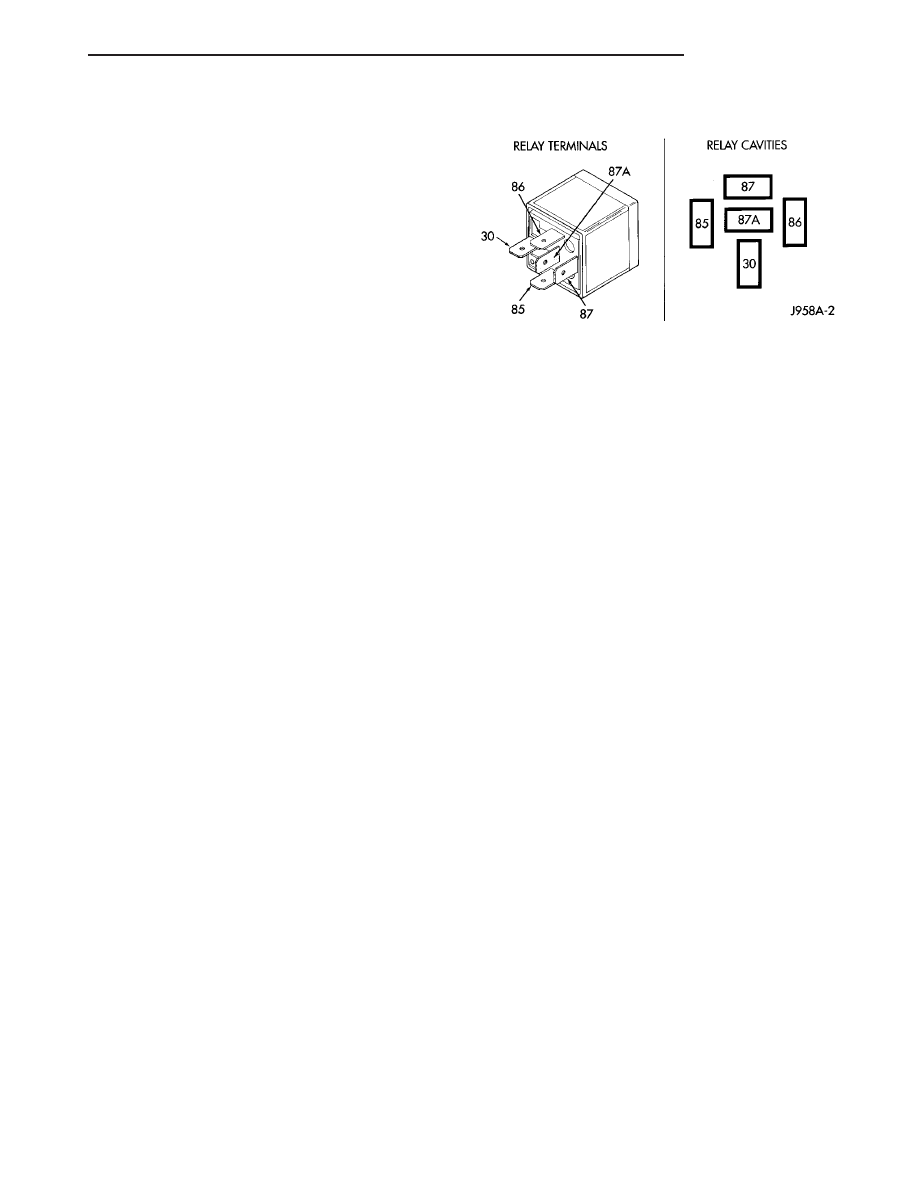Chrysler 300M, Dodge Interpid. Manual - part 73

STARTER MOTOR RELAY
DESCRIPTION
The Starter Relay is a micro relay located in the
Power Distribution Center (PDC), positioned in the
left front corner of the engine compartment.
OPERATION
As battery power is applied to the relay from the
ignition switch, battery power is applied to the
starter motor through the relay to the starter sole-
noid.
DIAGNOSIS AND TESTING - STARTER RELAY
WARNING: CHECK TO ENSURE THAT THE TRANS-
MISSION IS IN THE PARK POSITION/NEUTRAL
WITH THE PARKING BRAKE APPLIED
The starter relay is located in the Power Distribu-
tion Center (PDC) in the engine compartment. Refer
to the PDC label for relay identification and location.
Remove
the
starter
relay
from
the
PDC
as
described in this group to perform the following tests.
Refer to Starter Relay Chart for terminal numbers
and locations.
(1) A relay in the de-energized position should
have continuity between terminals 87A and 30, and
no continuity between terminals 87 and 30. If OK, go
to Step 2. If not OK, replace the faulty relay.
(2) Resistance between terminals 85 and 86 (elec-
tromagnet) should be 75 ±5 ohms. If OK, go to Step
3. If not OK, replace the faulty relay.
(3) Connect a battery B+ lead to terminals 86 and
a ground lead to terminal 85 to energize the relay.
The relay should click. Also test for continuity
between terminals 30 and 87, and no continuity
between terminals 87A and 30. If OK, refer to
Starter Relay Circuit Test procedure. If not OK,
replace the faulty relay.
STARTER RELAY CIRCUIT TEST
(1) The relay common feed terminal cavity (30) is
connected to battery voltage and should be hot at all
times. If OK, go to Step 2. If not OK, repair the open
circuit to the PDC fuse as required.
(2) The relay normally closed terminal (87A) is
connected to terminal 30 in the de-energized position,
but is not used for this application. Go to Step 3.
(3) The relay normally open terminal (87) is con-
nected to the common feed terminal (30) in the ener-
gized position. This terminal supplies battery voltage
to the starter solenoid field coils. There should be
continuity between the cavity for relay terminal 87
and the starter solenoid terminal at all times. If OK,
go to Step 4. If not OK, repair the open circuit to the
starter solenoid as required.
(4) The coil battery terminal (86) is connected to
the electromagnet in the relay. It is energized when
the ignition switch is held in the Start position.
Check for battery voltage at the cavity for relay ter-
minal 86 with the ignition switch in the Start posi-
tion, and no voltage when the ignition switch is
released to the On position. If OK, go to Step 5. If
not OK, check for an open or short circuit to the igni-
tion switch and repair, if required. If the circuit to
the ignition switch is OK, refer to the Ignition Switch
Test procedure in this group.
(5) The coil ground terminal (85) is connected to
the electromagnet in the relay. The relay is grounded
through Pin 8 of the PCM, when the gear selector
lever is in the Park or Neutral position. Check for
continuity to ground at the cavity for relay terminal
85, when the gear selector lever is in the Park or
Neutral position. If not OK, check for an open circuit
to Pin 8 of the PCM and from Pin 76 of the PCM to
transmission range sensor. Repair as necessary. If
both circuits are OK, refer to the Transmission
Range Sensor Test in Transaxle. If the Transmission
Range Sensor test OK, and all other tests are OK,
replace the PCM.
REMOVAL
The relay is located in the Power Distribution Cen-
ter (PDC). Refer to the PDC cover for relay location.
STARTER RELAY CHART
LH
STARTING
8F - 29